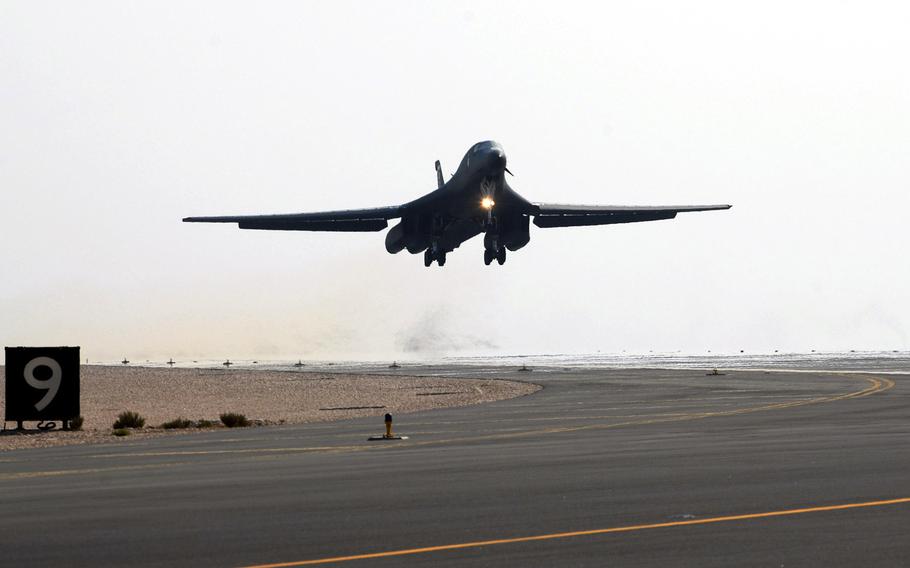
An Air Force B-1B Lancer takes off from a runway in Southwest Asia for a mission in support of Operation Enduring Freedom. University of Oklahoma engineering students Tristen Portis and Rick Lucio worked with their adviser, Kuang-Hua Chang, Williams Companies Foundation presidential professor in the School of Aerospace and Mechanical Engineering, to fix a low rudder of a B-1B aircraft. (U.S. Air Force)
(Tribune News Service) — The work of two recent University of Oklahoma engineering students has landed them full-time jobs at Tinker Air Force Base.
Tristen Portis and Rick Lucio worked with their adviser, Kuang-Hua Chang, Williams Companies Foundation presidential professor in the School of Aerospace and Mechanical Engineering, to fix a low rudder of a B-1B aircraft, which are no longer being manufactured.
Rockwell International manufactured 104 of the supersonic strategic heavy bombers between 1973 to 1988.
The company was acquired by Boeing Integrated Defense Systems in 2001.
Chang said Tinker can't go to the original company to make repairs as it doesn't exist anymore, and Boeing doesn't make enough money off these kinds of repairs to make it worth its time, leaving the military base to outsource its repairs to a third party.
"The problem is complex. [The manufacturer] does not know what caused the problems, so it is hard for them to try to repair and come out with good parts, therefore, they need someone capable of figuring out the fundamental causes that led to the defects," Chang said. "We have expertise, and we know the use of engineering technology."
Chang also said because the planes have been out of fabrication for so long, the original manufacturing tools no longer exist.
"They may have lost the team, the engineers, or their own suppliers who were manufacturing the low rudder years ago. For this particular case, the original technical data package like engineering drawings, including machine specifications, may be lost," he said. "Tinker is constantly struggling to come up with good parts that can be installed to their airplanes."
He said OU has computer technology that can mimic flight simulations and the physical manufacturing processes for reconstructing aircraft parts.
Portis said Tinker has a division to make its own parts, but it has underperformed, partly because its bond jig table, or curing table on which parts are fired, is responsible for destroying its products.
"Half of them are no good, so they have to make another one, and that's wasted materials and wasted time," Portis said. "It's this big metal table that holds the B-1B lower rudder. It holds the part during firing."
The rudders, which contain a honeycomb-designed filling, need to be isolated during the curing process.
"Basically, we're gluing the honeycomb to the skins of the outside pieces of the rudder. It's to cure the glue and make sure it sticks properly without crushing the honeycomb inside it. That's their biggest problem right now," Portis said.
He said non-uniform thermal expansion caused the lower rudder to expand unequally, causing deformations, which prompted the crushing of the honeycomb interior. After identifying the problem, Tinker brought on OU students to come up with solutions.
"I helped shape the new design. It was mostly small stuff, like adding handles here and there and making it easier to manufacture," he said. "It was my job to keep our computer aided design models updated."
He said before OU was brought on, the aircrafts were not operable.
"Your lower rudder is pretty important," he said. "Especially when you are flying the aircraft., Without it, you can't turn side to side without banking your aircraft left and right. It would make landing and taking off very difficult, or flying in the crosswinds."
Portis and Lucio graduated from OU this spring.
"I came a year and a half into the project, and at that point we were reviewing our analysis and making decisions on what direction to head in," Lucio said. "I was tasked with one of the initial phasing and implementing design changes based on our analysis."
The two students were offered full-time jobs at Tinker following their graduations.
"I would say this project helped my chances to get this job," he said. "When I was interviewed for the position, they were definitely very interested in the experience I gained from this project."
He said projects like these are important for students because they implement theory learned from the classroom.
"I had some previous introduction into finite element analysis, but this was definitely a real world application," said Lucio.
At the time, the students were not in any way employed at Tinker.
Chang said he has been working with Tinker for 25 years on similar projects, but this was by far the most "technically challenging." He said it was important to introduce these issues to his students to involve them in real-world application.
"I am a professor at OU and my duty is not just to work on projects like this, but I have to teach classes and advise students and offer my technical services to the department," he said. "I need help from students to carry out numerous engineering tasks, and in the meantime they are getting valuable experience working on these practical projects."
(c)2023 The Norman Transcript (Norman, Okla.)
Visit www.normantranscript.com
Distributed by Tribune Content Agency, LLC.